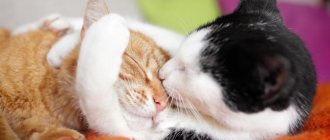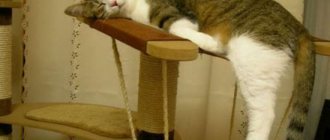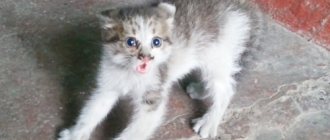It involves using special devices, such as a cat repeller. However, this is far from the only remedy; there are many others. We will tell you what they are and how they differ below.
Cat repeller: purpose and principle of operation
Cats are cute creatures until they begin to show their stubbornness and animalistic habits. This animal creates a lot of inconvenience when it enters an area where it is prohibited from entering. Repellers will help protect access. They do not injure the cat, but only irritate it, forcing it to quickly run away. The principle of operation of the devices is based on the emission of sounds, odors, unpleasant for the animal, sudden spraying or blinking. A repellent product is useful in the following cases:
- To protect beds and flower beds where cats like to go to the toilet or tear out and chew plants.
- To discourage homeless and neighborhood cats from entering your territory.
- To prevent your pet from entering rooms where he is not allowed to be (for example, a nursery or rooms with a computer, flowers, valuable antiques, etc.).
A cat repeller often becomes the only way to save flowers in an apartment or area from being torn out or eaten by curious cats.
What in general can keep cats away from the yard?
If you decide to start fighting against outside cats visiting your property, pay attention to such simple and effective methods as:
1. It is necessary to get rid of food sources in your yard, and most importantly, tightly close garbage containers, if any. Often, it is the accumulation of food waste, as well as food forgotten in the yard, that is the main magnet for other people's cats to visit your yard, prowling in search of food. If you have pets in your yard, you also need to hide their bowls after feeding them.
2. If possible, install moving lawn sprinklers in your yard. These devices have both automatic and manual watering modes, which allows you to activate the sprinklers when the cat first approaches your area and drive the insolent animal out of the yard for a long time. This method is very effective, but requires additional costs for installing an irrigation system and increased waste of water.
3. Plant special plants on your property whose smell repels cats. So, you can plant bushes of fragrant rue around your yard, since cats cannot stand its smell. In addition, you can collect fragrant rue in bunches and place them in the barn, along the fence, in the garden and at the doorstep. In addition to this plant, you can use citronella, lemongrass, eucalyptus and lavender. You can also purchase special scented oils with the scent of these plants, soak rags in them, and leave them in areas where cats appear.
4. Use a water gun as a repeller. As soon as you notice that a cat has appeared on your property, sneak up to it and spray it with a stream of water from a water pistol, which will shock the animal. For greater effectiveness, you can add vinegar, ammonia, acetone, or citrus and lavender flavoring to the water.
Types of repellers
Water devices can be used to repel cats in your yard. They are not suitable for the home, as they wet not only the uninvited guest, but also furniture, carpets, walls, and appliances. Ultrasound can be used to drive away cats both indoors and outdoors. But aerosol repellers are not suitable for open spaces (the smell quickly “dissolves” in the air); sprays are best used to limit cats’ access to rooms.
Water repellers
Such devices are sprinklers (water sprinklers). But unlike garden devices that turn on regularly and are intended for watering lawns and beds, repellers begin to accurately emit jets of water when motion sensors are triggered.
An example of a water repeller is Scare Crow. The device costs from 4800 rubles. The range is up to 10 meters. The sensor detects movement and sends a signal to the sprinkler, which is connected to a hose with water. The jet under strong pressure, moving from side to side, frightens a cat that has wandered into someone else's territory and forces it to hide.
The battery used is a 9 V battery, which is designed for 1000 sensor activations
The repeller works not only on cats. A device like Scare Crow is effective against raccoons, foxes, stray dogs, crows and other animals and birds. As a rule, after 1-2 “wet” attacks, the guest remembers that an unpleasant water procedure awaits him here, and no longer makes attempts to get into someone else’s yard.
Ultrasonic repellers
These devices, when triggered by a motion sensor, begin to emit sound at a high frequency. The human ear does not perceive it, but animals hear it well, and it is unpleasant for them. Ultrasonic repellers are suitable for the interior of houses, apartments, and for protecting yards. They protect not only from cats and stray dogs, they are also effective against rodents - mice, rats, moles.
Grad Duos S is an American model suitable for repelling animals less than 5 kg. The device's two speakers generate ultrasound, which is not perceptible to humans. For the animal, the sounds produced are perceived as a sudden clap of thunder. The cat hears acoustic signals at a distance of up to 20 meters. The price of the device is from 2900 rubles.
The device weighs only 120 grams and can be mounted on a wall or an inclined surface - for example, a door slope or an external cornice.
Weitech WK0055 is another example of an ultrasonic repeller. Cats do not like sound emitted with a frequency below 20 kilohertz (humans cannot hear it). Also affects rodents, foxes, small dogs, pigeons, crows. The device scans the space at a distance of 16 meters and with a coverage angle of 90° - as soon as an animal enters the zone, a sound signal is immediately triggered. The device stops “screaming” only when the animal leaves the area covered by the sensor. The advantage of the repeller is that it does not work from the mains, but from batteries, so it can be placed in any part of the apartment, house, or yard. Weitech WK0055 price - from 3500 rub.
The device has a durable, water-permeable body that is not afraid of rain, snow, sunlight and dust
Aerosol repellers
Deodorizing spray works by emitting a liquid with an unpleasant odor for the cat. It can be manual (when a person needs to “aim” at the animal and press the dispenser or treat surfaces) and automatic (the sensor detects the movement, transmits a signal to the sprayer and it sprays the uninvited guest with an aerosol).
An example of a simple repellent aerosol is BioVax. They can be used to treat rooms or individual pieces of furniture, flowers, wires so that the cat does not approach them. The base is essential oils of orange, cinnamon and pepper. The smell is quite persistent (one spray lasts for 3-4 days), but it is strong only for the first 30-40 minutes, then it becomes barely noticeable to humans, but the cat will continue to feel it.
This aerosol repeller costs from 150 rubles
What is not allowed when using ultrasound for cats?
The use of ultrasonic emitters used for educational purposes has rules, violation of which will harm health and negate the desired result:
- You can't keep it on all the time. Cats with a strong nervous system will get used to the annoying sound and stop reacting to it. Animals with a fine mental organization, unable to withstand the constant state of anxiety and impending danger, will try to escape to a “quiet” zone, get lost, become victims of stray dogs, or get run over by a car.
- You cannot bring the device to the animal’s ears; this does not threaten hearing loss, but the cat will be very scared. The situation can provoke a persistent feeling of fear towards the owner, the person who performed the manipulation.
The device does not cause physical harm, but its effect on the animal’s psyche in some cases is strong, leading to loss of appetite, sleep disorders, and stress.
Reasonable use of repellers helps to solve behavioral nuances, get rid of the unpleasant smell of tags in an apartment, on a property, eliminate damage to plants, the appearance of heaps, puddles in inappropriate places.
When spraying secluded places suitable for an animal to use as a toilet, you should take a closer look to see if the tray is too small for the cat, try changing its location, try switching to a different type of litter, or increase (decrease) its quantity.
Have you used any types of repellers, did they help in solving the situation, which type was the most effective?
| Summer will soon come and there will be a lot of mosquitoes, mosquitoes and other annoying midges. Therefore, I propose to assemble a diagram of a simple but very necessary device - an ultrasonic repeller. The proposed device will protect you both during work and during rest from mosquitoes and even from annoying barking dogs if you increase the frequency of the generator to ultrasound. |
The diagram of the ultrasonic repeller is shown below:
The sound-reproducing element of the device is a piezo emitter (ZP-1, ZP-3, ZP25... in general, any). With a slight modernization of the device, you can increase its power by adding a simple ULF and using a high-frequency speaker.
Operation of an ultrasonic repellent device. Diode VD1 is needed to protect against incorrect power connection. Power source - battery or accumulator with voltage from 1.5V to 9V. But it is better to give the maximum voltage, since with increasing voltage the radiation power of the device increases and, accordingly, the efficiency. The frequency of the generator depends on the capacitance C1 and C2, and the resistance R1. Several more piezo emitters can be connected to the contacts of the ZP-shki. It is advisable to choose models that are more powerful.
How to make a repeller with your own hands
Of course, not everyone can make an electrical device with a water sprayer or ultrasonic alert. But a simple aromatic remedy that will help keep cats at a distance from the room or individual objects can be made in a couple of minutes from the most common ingredients. Homemade repellers contain substances with unpleasant odors for cats. They mainly use vinegar, essential oils, garlic, pepper, and citrus fruits.
From a mixture of essential oils
For an aromatic cat repeller, you can use oils of lemon, lavender, orange, eucalyptus, sandalwood, mint (use one product or make a mixture). Dissolve 6 drops of essential oil in 150 ml of water poured into a spray bottle. Shake the liquid - and that’s it, after that the repeller is ready. It can be used to treat any object (wires, flower leaves, sofa) that needs to be protected from cat vandalism. Light-colored fabrics should not be watered with a solution containing oils, as yellow stains may remain.
Essential oils for the repeller can be bought at any pharmacy or cosmetic store (one 15 ml jar costs on average 280–420 rubles)
From vinegar
Pour 5 liters of water into a container and add 5 tablespoons of vinegar (apple or wine). To enhance the effect, you can add a handful of dry lavender. Then close the lid and let it brew for 1-2 days. The resulting infusion should be used to treat the floors of the room where the cat’s access is undesirable. The vinegar smell will last for the first hours, but then the person will stop feeling it, but the animal will feel the aroma for another 3-4 days (then the procedure can be repeated).
Vinegar irritates the cat's mucous membranes and causes sneezing, so the animal tries to avoid this product.
From spices
To make the product you will need a small spray bottle (60–100 ml). Add one teaspoon each of black pepper, dry mustard and cinnamon. The smell will be even more disgusting for the cat if you add a drop of citrus oil and a crushed clove of garlic to the mixture. Everything is filled with water and shaken up. Please note that the resulting product will be unpleasant for humans, so it is better not to use it in living rooms. It can be used to treat outdoor plants, surfaces in non-residential premises (balcony, bathroom, greenhouse, etc.) that the cat marks or chews. Do not spray the repeller in the cat's face (spices cause irritation of the mucous membranes).
From citrus fruits
Peels from oranges, tangerines, grapefruits, lemons, limes and other citrus fruits are used as components for this repeller. The skins are poured into a pan and filled with water in a ratio of 1:5. They need to be cooked for 40–50 minutes over low heat. The cooled broth should be used to treat surfaces in rooms where cats are prohibited from entering. The procedure must be repeated every 2–3 days.
You can treat tables and countertops in the kitchen with a citrus decoction - thereby weaning the cat from jumping on them
Remove cat tags
Cats regularly mark their territory, and cats also know how to leave “notes” to their furry comrades by rubbing their whiskers against different surfaces. Such tags attract animals, being an analogue of our social networks. And if your fence has been chosen as a chat, then getting rid of the influx of visitors will not be easy.
You will have to regularly remove cat odors, and then spray the area where the animals rub with substances that are unpleasant to them. Vinegar, lemon juice, iodine, etc. work well for this task. After the animal discovers something completely different from what it expected several times in a row, the “correspondence” will stop or move to another place.











